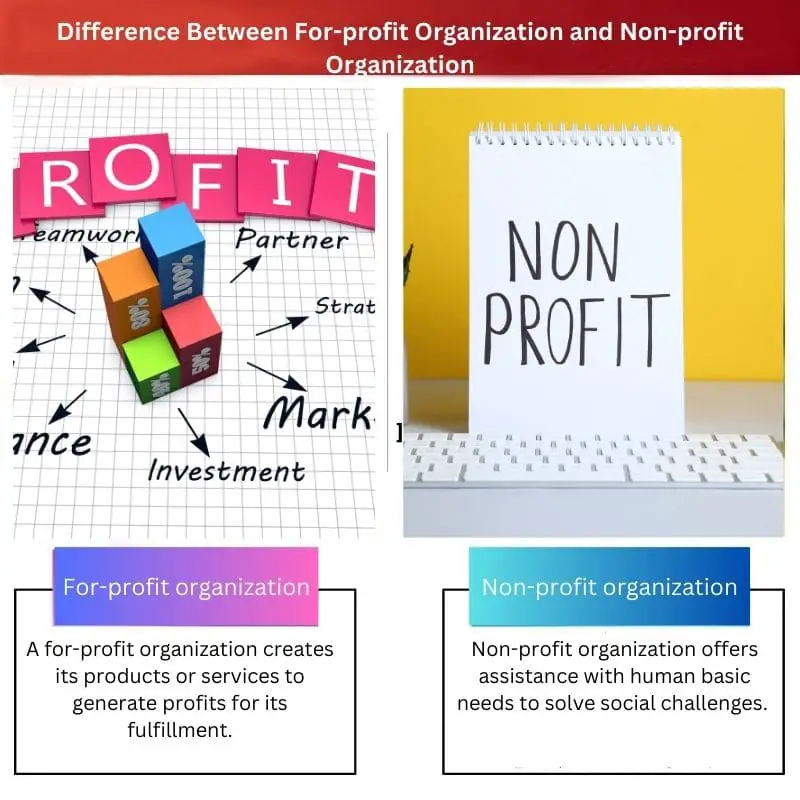The term “organization” simply stands for people who are organized in a group to fulfil a particular which is directly related to the fiscality of the business. In this way, an organization can be divided into for-profit organizations and non-profit organizations.
For-profit organization benefits on their own whereas non-profit organization is meant for public benefits.
Key Takeaways
- For-profit organizations aim to generate revenue and distribute profits among shareholders.
- Non-profit organizations focus on social, environmental, or charitable objectives without distributing profits to individuals.
- Tax structures and legal requirements differ between for-profit and non-profit organizations.
For-profit Organization vs Non-profit Organization
The difference between for-profit and non-profit organization is that for-profit organization mainly focuses to make profits for their own will whereas non-profit organization makes profits to help society. The for-profit organization expects a return on its investment. On the other hand, non-profit organizations seek donations from individuals, foundations, and corporations.

As the name suggests “for-profit”, for-profit organization aims to generate profit through operations and interests.
It plays a vital role as a capitalist or a free-market economy, it doesn’t only help the government to increase corporate tax by providing income as well as it provides jobs to the people of a country.
Non-profit organization is sometimes known as NPOs or 50(c)(3) organizations which are based on the section of the tax code that permits them to operate.
The only way to gain public confidence is to focus on their respective mission which is done for the welfare of society. Whatever assets and income of the non-profit organization are meant to be reinvested into the organization and donated.
Comparison Table
| Parameters of Comparison | For-profit organization | Non-profit organization |
|---|---|---|
| Objective | For personal fulfillment. | To serve society. |
| Managed by | Sole proprietors, partnerships and companies. | Trustees, committees that don’t have financial ownership directly on organization. |
| Fund | By initial capital investment. | By donations. |
| Taxation | Have to pay taxes. | Exempted from paying taxes. |
| Net proceeds | Paid out as dividends. | Re-invested in the charitable mission. |
What is a For-profit organization?
A for-profit organization is also referred to as a for-profit corporation. This type of organization falls under the private sector as they are not aided by the government and works for its financial aims.
As a result, they have to pay taxes which is required by the law but when the for-profit organization donates to the non-profit organization that can lead to tax deductions.
For-profit organizations can be divided into public companies and private companies.
In public companies, the public can buy shares of the company, whereas in private companies purchase and sale of private company shares cannot buy and share be done freely as it takes place privately.
This kind of organization can be profitable for the country’s economy as more they earn leads to an increase in the amount to pay taxes which is directly spent back on the people of the country.
The more is productivity; the more is GDP which is linked to a higher living standard.
When it comes terms of personal motives, more profit is equal to more investment in the business, which led to increasing its speed of growth.
Across the world, most of the businesses are meant for-profit organizations. Even any local shop, supermarket, and café can be included in a for-profit organization.

What is a Non-profit organization?
The non-profit organization is also known as a non-business entity, non-profit institution, or not-for-profit organization. It is organized to benefit the public or society and tackle challenges faced by society, such as poverty, education, and many more.
As non-profit organization generates benefits for society, the government exempts them from paying taxes as they get this status from Internal Revenue Service (IRS).
In case, revenue exceeds, then it should be committed to the organization’s benefits and not to private parties. Non-profit organizations are not run completely by volunteers as most of them have staff that works for the company.
A misconception about the non-profit organization is that they may not make a profit whereas they have to operate a fiscally responsible business.
As a result, they manage their income and expenses to sun business responsibly. In this kind of organization, there is a need to set up a mission that is effective to generate as much as the fund for the organization.
The conditions for an effective mission are commitment, opportunities, and competence.
For funding, they rely on external sources, including donations. In case, funds are mismanaged or misdirected it could result in loss of status as well as loss of funding from both public and private sources.

The main difference between a For-profit organization and a Non-profit organization
- A for-profit organization creates its products or services to generate profits for its fulfilment. In contrast, non-profit organization offers assistance with basic human needs to solve social challenges.
- The for-profit organization seeks to establish their relationship with clients as they mainly focus on generating revenue, whereas the non-profit organization tries to get a more diverse audience, such as donors, volunteers, and the general public, etc.
- Organizational culture is different for a non-profit organization and for-profit organization as the latter focuses on financial gain and values employees for their contribution to increasing revenue. The non-profit organization is community-oriented and supports the cause outside its regular schedule.
- In a for-profit organization, whatever money is earned over and above is transferred to a capital account, whereas the surplus, which is generated by the non-profit organization, is transferred to the capital fund.
- The financial statement of a for-profit consists of a balance sheet, income statement, and cash flow statement. And for the non-profit organization, it is income and expenditure A/C, receipt, and payment A/C and balance sheet.




